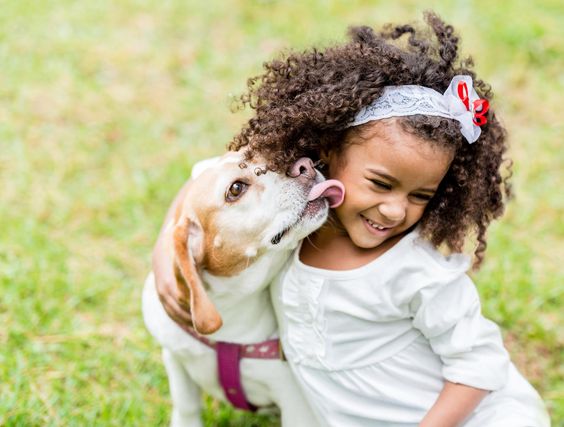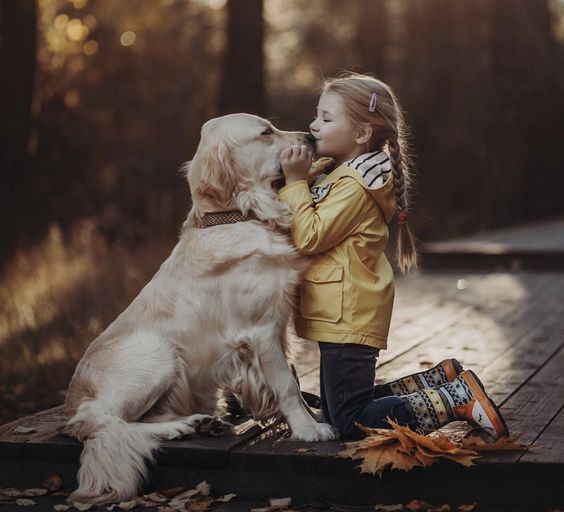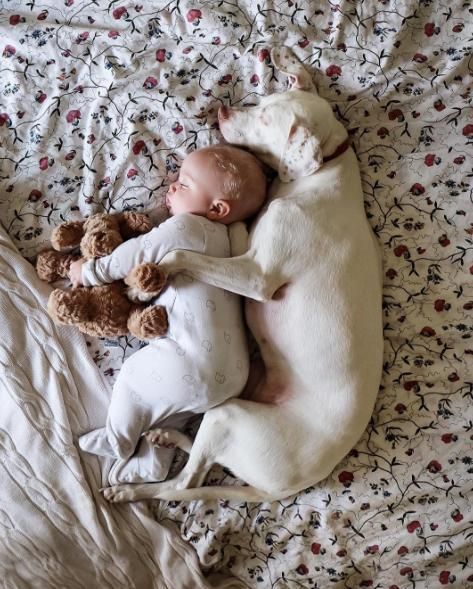Train your dog to be safe with kids, as a parent or pet owner looking for ways to ensure that your kids and furry friends can coexist peacefully? Teaching your dog to be safe around children is essential. With the right guidance, you can create a positive environment where both are happy and secure.
Here are some tips on how to train your dog to be safe with kids.
It’s important to recognize that dogs need time and patience in order to learn new behaviors. Set aside at least 10-15 minutes each day for training sessions with your pup, and remember that consistency is key!

Start by teaching basic commands such as “sit” or “stay”; this will help establish boundaries between the two and provide structure for their relationship moving forward.
Additionally, socializing your dog regularly will help him become comfortable around people of all ages, including children.
Lastly, reward good behavior so they understand the desired outcome when interacting with kids—this could include treats or verbal praises like “good boy/girl” or you can call them by name starts with J!”
With these simple steps, you can create a safe space for both of them—allowing your kids and pup to live happily together.
Establish a Positive Environment
Establishing a positive environment is key to train your dog to be safe with kids ensuring your pup and children can interact happily and confidently, start with creating an atmosphere of mutual respect, trust, and love.
You can begin by introducing your pup to the children in a controlled setting; use positive reinforcement methods like a reward system to encourage desirable behavior. Make sure that both your pup and the children understand what actions are acceptable so each party knows their boundaries.

When interacting with the kids, provide lots of praise for desired behaviors such as sitting when asked or playing gently. Be sure to pair positive reinforcement with rewards like treats or toys so your pup understands when they do something good they will be rewarded for it.
This reward system should be used consistently until your pup is comfortable around the children; it’s important that you take things slowly so as not to overwhelm them.
It’s also important that you create guidelines for the children regarding how they should interact with dogs; this includes teaching them not to approach unknown animals and letting them know how to conduct themselves if they’re ever around a dog.
Provide gentle reminders about these rules whenever necessary and let them know that following these guidelines will help keep everyone safe – including their four-legged friend!
Teach Basic Commands

Start train your dog to be safe with kids teach your pup the basics now; it’ll help ensure they’re comfortable and confident around children. Using a positive reinforcement and reward system, you can teach your dog basic commands like sit, stay, come, down, leave it, and drop it. This will help them understand what is expected of them when interacting with kids.
Here are five tips to get started:
- Start by teaching your pup one command at a time in short sessions.
- Use treats or toys as rewards for good behavior.
- Be consistent with commands and rewards so that your pup knows what to expect each time.
- Make sure to give lots of praise when they do something right!
- If your pup isn’t responding well to a particular command, take a break and try again later.
Teaching basic commands is an important part of training your dog to be safe around children. It’s also important to remember that dogs learn best through repetition and consistency, so don’t give up if things aren’t going perfectly right away! With patience and practice, you can help create an environment where everyone feels safe and secure in bonevoyagedogrescue.
Socialize Your Dog
Getting your pup comfortable around people and other animals is essential for creating a stress-free, happy environment everyone can enjoy! The best way to socialize your dog is through positive reinforcement. This means rewarding them with treats, praise, and attention when they interact in a friendly way with others. Pay attention to your pup’s body language as well; if they appear scared or uncomfortable, don’t push the interaction too far.
| Positive Reinforcement | Body Language |
|---|---|
| Treats | Scared |
| Praise | Uncomfortable |
| Attention |
Encourage your pup to be confident in unfamiliar situations by introducing them gradually to new people and places. Start out at home by inviting friends over who are patient and understand how to interact appropriately with dogs. After your pup has experienced these familiar settings positively, you can begin taking them out into the world. These outings should start off in low-stress environments such as parks or pet stores so that they can safely get used to new scents and sounds without feeling overwhelmed or anxious.
When introducing your pup to children, it’s important for both safety and trust that the process is done slowly and carefully. Bring treats along on walks so you can quickly reward good behavior if needed while still maintaining control of the situation; also make sure that any children involved know not to pull on ears or tails or hug too tightly while interacting with the dog. With patience and consistent practice, socializing your pup will become second nature in no time!
Set Boundaries
To ensure your dog is safe to be around kids, it’s important to set some boundaries.
First of all, it’s essential that your dog training not to bite or jump on people.
Secondly, it’s important that any interaction between your dog and a child should always be supervised by an adult.
Lastly, if you’re introducing your dog to a new child in the home, take time for both of them to get used to each other before they’re left alone together.
No Biting or Jumping
Let’s help Fido learn to not jump up or bite – it’ll make everyone happier! Teaching your dog how to be safe around kids starts with setting boundaries.
An important part of this is teaching your pup that jumping and biting are never appropriate, no matter the situation. Training your dog to understand that these behaviors won’t be tolerated can help protect children from potential harm and prevent any negative interactions.
Introducing new experiences in a positive way is key when training your dog. This includes introducing them to new people, children or even other animals.
When playing together, it’s important for both parties to maintain appropriate play behavior; if either one begins to get too rough, have them take a break so they can calm down before continuing the activity. By providing consistent rules for interaction, you can ensure that Fido knows how to safely interact with others – including kids!
No Unsupervised Interactions
Now that your pup’s learned not to bite or jump, it’s time to discuss the importance of no unsupervised interactions.
When enforcing rules for your dog around children, supervised play is key. That means a responsible adult should always be present when kids and dogs are interacting. Even if you know your pup won’t hurt a child, it’s best to avoid any potential accidents by making sure someone’s watching at all times.
Unsupervised play can lead to both physical and emotional trauma for children as well as pets involved in the interaction. Kids may unintentionally do something that could startle or frighten your pup, which could lead them to bite out of fear-based aggression or pain-based aggression due to an accidental injury caused by the child.
On the other hand, kids can also unintentionally encourage bad behavior from their furry friend like jumping up on them or nipping at their hands during roughhousing. To prevent these types of situations from happening, make sure all playtime between kids and dogs is supervised so that you can intervene as needed and remind everyone about boundaries.
Reward Good Behavior
When your pup is around the little ones, give ’em a pat and a treat for being so cooperative! Rewarding good behavior by your pup when they are in close proximity to children is one of the best ways to train them into safe habits.
Positive reinforcement will help them understand that their behavior is accepted and appreciated, and it can also serve as an incentive for repeating that behavior. Praise rewards are especially effective, such as verbal affirmations such as ‘good boy’ or ‘good girl’. This type of reward reinforces the desired behavior with immediate gratification.
Rewards should be consistent, which allows your pup to learn quickly what kind of behaviors are expected of them. If you praise one action but not another, or if you don’t reward an action at all, then your pup may become confused about what actions lead to positive reinforcement.
Thus it’s important that you provide consistent and clear rewards for good behaviors when around kids. It’s also key to remember that rewarding your pup should always happen after they execute the desired behavior – this helps reinforce the idea that their good behavior has been noted and appreciated.
With both positive reinforcement in the form of rewards and consistency with regards to what kinds of behaviors result in those rewards, training your dog to be safe with kids becomes much more manageable!
Frequently Asked Questions
How often should I exercise my dog?
Exercising your dog is an important part of being a responsible pet owner. Regular exercise keeps your pup healthy and happy, and it can even help with behavioral issues.
Twice daily leashed walks are recommended for most dogs, but you can also use positive reinforcement to keep them engaged and entertained throughout the day. This could involve activities like playing fetch or going for a run or bike ride together.
With patience and consistency, you can create a fun yet safe exercise routine that will benefit both you and your pup!
Is it ok to scold my dog if it behaves inappropriately around children?
Scolding your dog when it behaves inappropriately around children isn’t always the best approach. Studies show that using positive reinforcement and socializing puppies from a young age is more effective for teaching long-term obedience.
That said, if you notice your pup exhibiting overly aggressive behavior, such as growling, snarling, or showing its teeth to a child, it’s important to intervene immediately in order to protect everyone involved.
With patience and consistency in training through positive reinforcement techniques like rewards and praise, you can help your pup learn how to interact safely with kids.
What is the best age for children to start interacting with my dog?
When it comes to socializing a dog with children, the best age for kids to start interacting is usually when they’re old enough to understand basic commands and instructions.
It’s important that you use positive reinforcement when teaching your dog how to behave around children so that it has a favorable attitude towards them.
Make sure the child knows not to startle or approach the animal without permission, and if their behavior isn’t appropriate, give them gentle reminders instead of scolding.
With patience and practice, your dog can be safe and comfortable around kids in no time!
How do I introduce my dog to a new baby in the family?
Introducing your dog to a new baby in the family can be an exciting and daunting task. To ensure that it goes as smoothly as possible, start by socializing your pooch with children ahead of time if you haven’t already.
Reward-based training will help reinforce positive behaviors around little ones and provide reassurance for both you and your pup. Be sure to allow supervised interactions between your pet and the baby while also giving them plenty of space away from one another when necessary.
With some patience and guidance, you can make this transition a safe one for everyone involved!
How do I know if my dog is uncomfortable around children?
Are you unsure if your dog is comfortable around children? You’re not alone. According to research, more than 50% of pet owners have difficulty discerning when their pet is feeling uncomfortable in a situation.
When socializing your dog with kids, pay close attention to their body language and be sure to set firm safety rules for both the child and the dog. Look out for signs such as avoidance, lip licking, avoiding eye contact, or turning away from the child; these are all indications that your pup may be feeling anxious.
Be patient and work on building trust between your pup and the kids gradually over time. With patience and consistency, you can ensure that everyone in your family enjoys a safe and happy relationship with your furry friend!
See Also
- The Pervasive Problem of Black Dog Syndrome
- The Majestic Bloodhound: A Guide to the Loyal and Tenacious Breed
- Best Dog Water Fountain
Conclusion
Training your dog to be safe around kids doesn’t have to be a daunting task. With the right guidance and patience, you can help your pup learn how to interact with children in an appropriate, safe way.
Establishing a positive environment, teaching basic commands, socializing your pup, and setting boundaries are all key components of successful training. Ultimately, the most important thing is to reward good behavior so that your pup knows when they’re doing something right!
With time and consistency, you’ll soon see a happy pup who loves interacting with kids in a safe manner – and that’s something worth celebrating!
Open your heart and home to a deserving furry friend today. Embrace the joy of adoption and give a second chance to a loving dog in need. Begin your incredible journey with bonevoyagedogrescue now!
